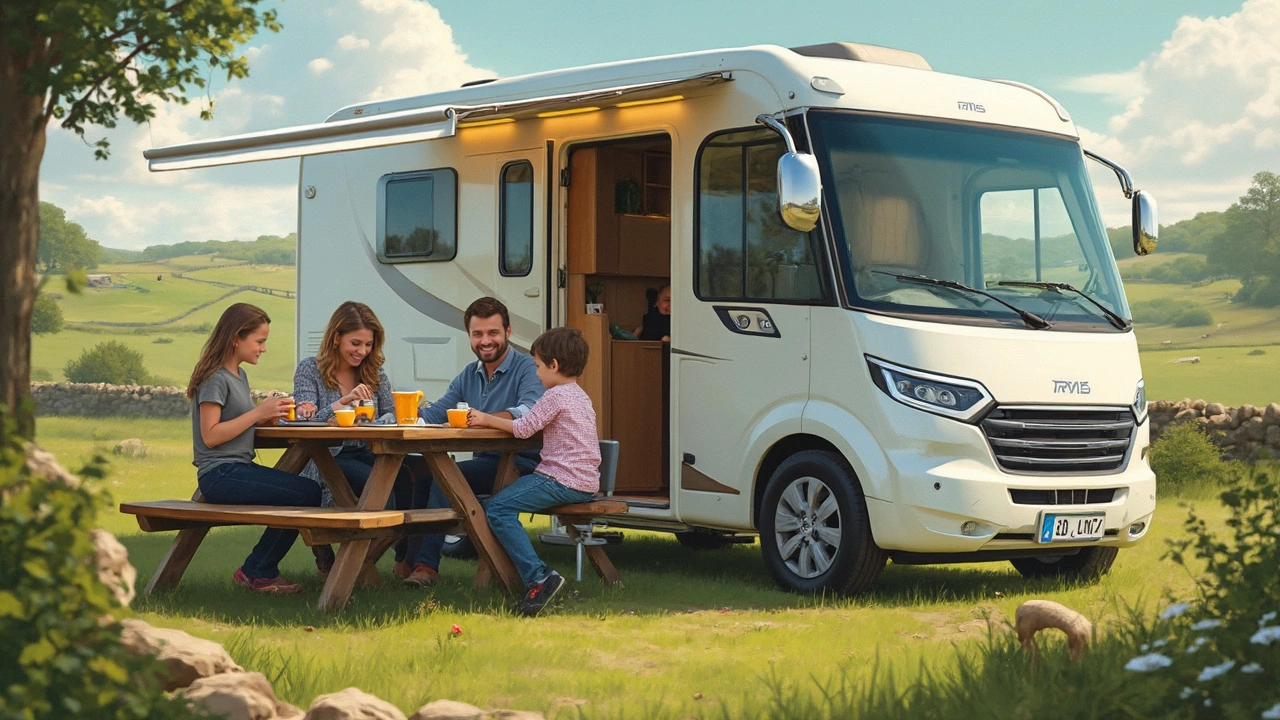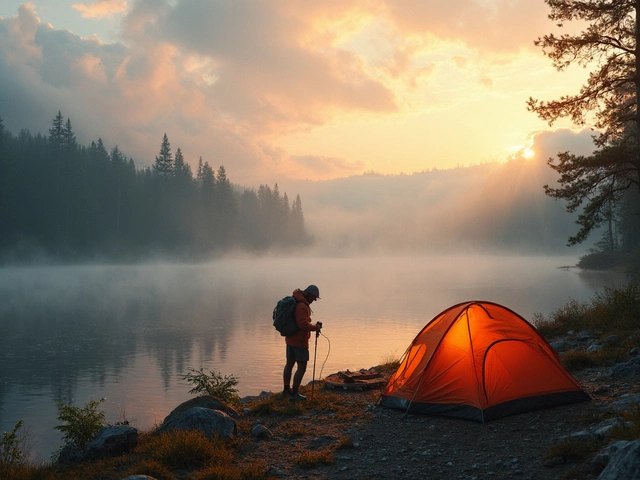If you think RV living means escaping bills and living for peanuts, reality might surprise you. The first thing most folks learn: it adds up quick, but it’s possible to keep things under control if you plan. The big numbers come from site fees, fuel, repairs, and little surprises on the road—each can swing your budget way up or keep it steady, depending on your choices.
For a lot of people, site fees carry the most weight. On average, monthly site rentals across the US range widely—from $400 in rural areas up to $1,200 (or more) in busy coastal spots or trendy snowbird locations. It’s not just about picking a cheap site, though; some pricier places include power, water, and Wi-Fi, which makes a difference in your total bill.
- What Are the Big Expenses?
- Typical Monthly Site Fees Across the US
- RV Utilities and Internet: What to Expect
- Hidden Costs Nobody Talks About
- Money-Saving Tips for Full-Timers
What Are the Big Expenses?
So, what are the real wallet-busters when it comes to RV living costs? It’s not just the price of gas—though that matters. The main costs can catch newbies off guard, especially if you’re not used to watching every little expense add up. Here’s where your money usually goes each month.
- RV living costs kick off with campground or RV park fees. If you’re staying full-time, this is your rent—expect to pay $700 to $1,500 a month for nicer parks in popular areas, but off-the-beaten-path sites can drop to $300 or less.
- Fuel is right behind. Even modest driving racks up costs fast when you get 8-12 miles per gallon. Hauling a big Class A cross-country? That’s $500 or more, depending on distance and gas prices.
- Maintenance isn’t optional—think regular oil changes, tires (at $250 to $600 each), and random repairs. Set aside at least $100 a month, but spikes to $500+ if something bigger fails.
- Insurance, registration, and taxes stick around too. Insurance for full-timers averages $1,200 to $2,000 a year. States like Texas or Florida keep registration fees reasonable, while others (like California) can sting.
- Food and groceries stay about the same as a house, but eating out adds up at truck stops or touristy towns.
- Internet and cellphone bills—most full-timers need a solid connection, so plan $100–$200 a month for the right gear and data.
Here’s a quick look at average monthly expenses for full-time RVers:
| Category | Monthly Cost (Typical Range) |
|---|---|
| RV Park Fees | $300 - $1,200 |
| Fuel | $250 - $800 |
| Maintenance & Repairs | $100 - $500+ |
| Insurance | $100 - $170 |
| Food/Groceries | $300 - $700 |
| Cell & Internet | $100 - $200 |
What tips the scale? How often you move, the age and size of your rig, whether you Boondock or plug in at fancy resorts, and how handy you are with repairs. Some folks get creative—workamping or volunteering keeps park fees low, and learning basic RV maintenance can save hundreds a year. Be real about your habits and where you want to go, and you’ll dodge a lot of the big surprises.
Typical Monthly Site Fees Across the US
If you plan to go full-time, knowing what you’ll pay each month for a spot to park is a big deal. RV parks and campgrounds across the US are all over the place price-wise, and it really depends on location, amenities, and even the season. You can find decent monthly rates, but prices shoot up when you’re closer to cities, the coast, or anywhere popular with snowbirds.
Here’s a quick look at what folks are actually paying as of early 2025:
| Region | Average Monthly Fee | What’s Usually Included |
|---|---|---|
| Southeast (FL, GA, AL, SC) | $800–$1,200 | Full hookups, basic Wi-Fi, laundry |
| Southwest (AZ, NM, TX, NV) | $500–$900 | Electric, water, basic amenities |
| West Coast (CA, OR, WA) | $1,000–$1,800 | Full hookups, some pool/gym options |
| Midwest (KS, MO, OK, NE) | $400–$700 | Water, sewer, electric, sometimes cable |
| Northeast (NY, PA, NJ, CT) | $700–$1,400 | Varies, usually full hookups |
Keep in mind, big resort-style parks with pools, event spaces, and spas will usually ask for a premium. On the other hand, smaller or city-owned campgrounds may offer cheaper long-term deals if you don’t mind fewer extras.
If cutting costs is your top goal, there are options. Some people spend less by rotating between cheaper municipal parks or fairgrounds, or using membership clubs like Thousand Trails. Boondocking—camping for free without hookups on public land—is another way to skip fees, especially in the West, but you’ll deal with more DIY when it comes to power and water.
No matter where you set up, always ask what’s included in the price. Hidden costs for electricity, Wi-Fi, or a dump station can sneak up if you don’t check the fine print. RV living costs are most predictable when you take the time to compare sites and understand what you get for your money.

RV Utilities and Internet: What to Expect
Utilities in an RV aren’t the same as in a house—you pay for what you use, and sometimes you get hit with extra charges beyond your site fee. Water, sewer, and trash are usually rolled into the price at most parks, but electricity can go either way. Monthly sites often charge electric separately, so expect to shell out anywhere from $30 to $150 a month depending on your AC use, appliances, and the state’s power rates. For short stays, the park often covers it.
If you plan on boondocking (camping with no hookups), you’ll need to queue up other ways to power your rig—solar panels, generators, or battery packs. Buying propane for heat or cooking is another must; most folks spend about $30 to $60 a month for propane, but it spikes if you’re wintering somewhere cold.
Internet is a big deal for most full-time RVers. Campground Wi-Fi is notorious for being patchy or straight-up unusable, especially if the site is packed. Most serious RVers use a combo of mobile hotspots, cell boosters, and, lately, Starlink for solid coverage. Expect to spend $50 to $150 a month for decent data—Verizon and T-Mobile are the heavy hitters, but coverage will still depend on where you park. Satellite options like Starlink run about $120 a month (plus upfront for equipment), but they’ve been game changers for remote work and streaming.
Here’s a quick breakdown of average monthly costs for popular RV utilities and internet options:
| Expense | Average Monthly Cost (USD) |
|---|---|
| Electricity | $30–$150 |
| Propane | $30–$60 |
| Water/Sewer/Trash | Usually included |
| Internet (Mobile Hotspot/Data) | $50–$150 |
| Internet (Starlink) | $120 |
Trick for saving money? Get good at monitoring your usage. Use energy-efficient appliances, and don’t forget to double-check what’s covered in your site fee. If you rely on RV living costs as your budgeting keyword, tracking utilities is what helps avoid nasty surprises each month.
Hidden Costs Nobody Talks About
Here’s the stuff that people gloss over on Instagram: RV living costs don’t end with site fees and gas. There are sneaky extras that can blindside you if you don’t know what to expect.
- Repairs and maintenance: Stuff breaks, and usually when you’re nowhere near a cheap repair shop. Expect to shell out for things like slide-outs refusing to slide, roof leaks, or troubleshooting that random beep in the middle of the night.
- Propane and special equipment: Heating, cooking, and sometimes even your fridge needs propane, and it’s not as cheap as you’d think. Plus, hoses, water filters, and surge protectors add up.
- Insurance quirks: Full-timer insurance is pricier than regular RV insurance. Some companies also make you carry more liability if you list your RV as your main home.
- Mail forwarding and domicile fees: You need a legal address for licenses, voting, and taxes. Services for mail forwarding aren’t crazy expensive, but they’re real, ongoing costs.
- Storage and memberships: If you have seasonal gear, or you want access to discount campground plans, you’ll pay annual fees. Also, if you keep things in a storage unit, that bill never stops.
- Gear and gadgets: Boosters for cell service, extra insulation, and small repairs pop up more often than you'd think—not all of them are optional if you want decent internet or to avoid freezing pipes.
Caught off guard by these? You’re not alone. Check out this breakdown of typical annual extras most full-timers encounter:
| Hidden Expense | Typical Yearly Cost (USD) |
|---|---|
| Repairs & Maintenance | 1,000–3,000 |
| Propane & Equipment | 300–700 |
| Mail Forwarding | 150–250 |
| Storage Unit | 600–1,500 |
| Campground/Membership Fees | 100–700 |
| RV Insurance (Fulltimer) | 1,000–2,400 |
If you want to keep from getting nickel-and-dimed, build a buffer into your budget for these hidden extras. Track your spending for the first six months on the road—you’ll spot patterns fast and can adjust before things get out of hand.

Money-Saving Tips for Full-Timers
Stretching your dollar as a full-time RVer isn’t about pinching every penny—it’s just knowing where people usually overspend and using a few smart tricks.
First up, consider joining campground membership clubs. Thousand Trails, Passport America, and Escapees slash nightly rates at hundreds of parks. Some memberships pay for themselves in a couple months if you park often. If you plan to stay in one spot for a while, ask about monthly versus nightly rates. Long-term usually wins.
Boondocking, or camping for free without hookups (think public lands like BLM and national forests), isn’t just for the adventurous—it’s a proven way to keep RV living costs down. With a little solar or a generator, people comfortably dry camp for weeks.
Fuel is the wild card in your budget, especially if you love moving around. Planning your route to minimize backtracking and avoid high-gas-price states makes a big dent. Even slowing down from 70 to 60 mph can boost mileage by up to 20% in some rigs.
Cooking your own meals beats eating out—no surprise there. Many full-timers use crockpots, instant pots, or compact grills to kick up meals without burning through propane or electricity.
Here’s a quick look at average monthly savings if you follow a few key habits:
| Money-Saving Tip | Avg. Monthly Savings |
|---|---|
| Membership discounts | $50-$150 |
| Boondocking (10 nights/month) | $200-$450 |
| Meal prep vs. eating out | $100-$300 |
| Fuel route planning | $30-$80 |
Don't skip routine maintenance—swapping a $30 air filter on time can save you hundreds in MPG each year. And watch your internet plan. Some full-timers accidentally rack up fees by going over data caps, so look for providers with unlimited or flexible RV plans.
Lastly, connect with the RV community—many groups share deals, warn about price hikes, and help you avoid overpriced tourist traps. Follow these habits, and those fulltime RV costs won’t get out of hand.






